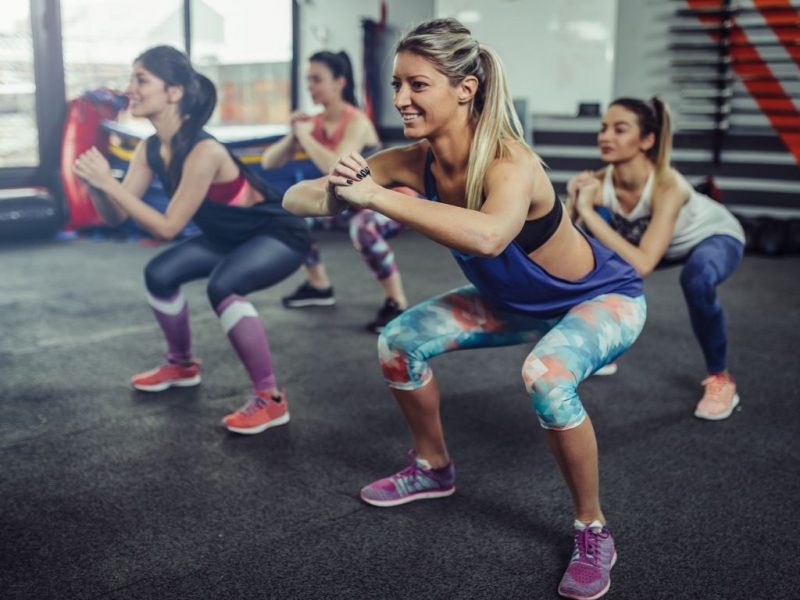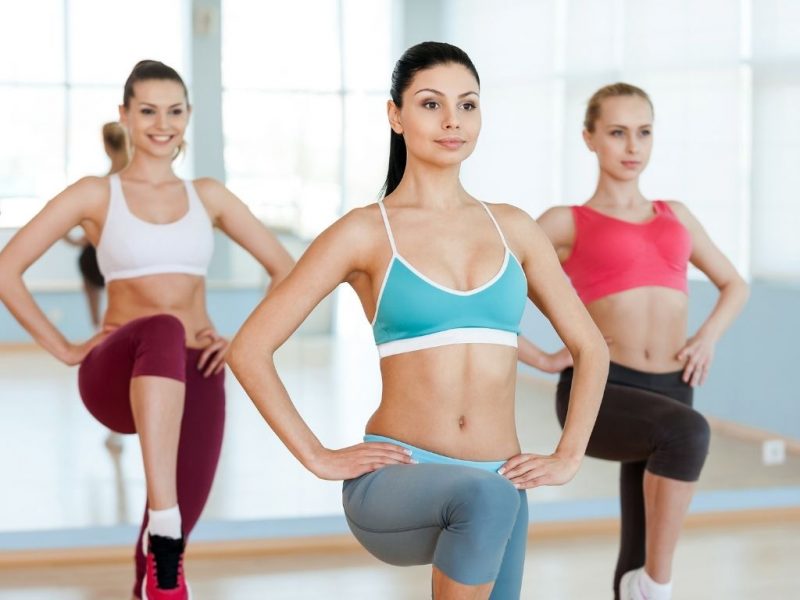Aerobic training is a great workout type as it effectively burns fat, boosts metabolism, helps with toning our body and has a good effect on our breathing and circulation as well. It never gets boring either, as there are many different types of exercises. When it comes to more intense aerobic training though, there is a greater risk of injuries, so we should take warming up seriously.
This article explains how to prepare for an aerobic class in detail.
- Why is aerobic training good for you?
- What is a well-structured aerobic class like?
- What should we pay attention to during warm-ups?
- Aerobic warm up exercises
Why is aerobic training good for you?
Aerobic training has long been one of the most popular sports among women. Doing sports in a group with great music guarantees a good mood, and the positive experience lasts for hours even after exhausting training. We recommend that you go to group classes, as your training buddies can be a huge motivation. If you don’t have the opportunity though, you can also train at home – there are many videos that you can watch online. Those who do not like intense training or simply do not feel fit enough to do it can choose from a variety of aerobic classes designed for body-toning and losing weight. Some people prefer classes with dancing and boxing elements, and different exercises requiring some equipment, such as Kangoo or spinning, are also available to everyone.
What is a well-structured aerobic class like?
The more active the workout is, the greater emphasis should be put on the muscles and joints, that is, on warming up. A thorough warm-up should last for at least 10 minutes. This way, we can minimize the risk of injuries and muscle soreness. The warm-up is followed by the aerobic phase, the aim of which is to improve endurance. The aerobic phase consists of three parts: the preparation, the active aerobic phase, and cooling down.
Preparation serves as a transition between the warm-up and the active phase. During this phase, the heart rate increases, and our circulation, respiratory system, and joints are prepared for active training with a gradual increase in intensity.
During the active phase, the focus is on endurance training, with the help of basic steps and jumps, all with a well-structured choreography. In the cool-down phase, intensive training is replaced with low-impact rhythmic exercises; we decrease the number of breaths and can even add some stretching exercises.
Depending on the type of aerobic training, the aerobic phase might be followed by a phase concentrating on muscle growth, and the session always finishes with thorough stretching.
What should we pay attention to during warm-ups?
The purpose of warming up is to prepare your body for active work. During warm-ups, our circulation is enhanced, and our muscles reach the appropriate “operating temperature”. More fluid is produced in the joints so that they become well-oiled, the range of motion is extended and the risk of joint injuries is decreased. Furthermore, besides your body, your nervous system is also prepared for the task at hand, which is very important, for instance, when it comes to more complex choreographies.
The length and intensity of warm-ups is affected by the type of aerobic training, the time of day (in the morning, the warm-up phase should be longer) as well as the composition of the training group (age, level of fitness, etc.).
Aerobic warm up exercises
Standing in a basic position or marching in place, inhaling and exhaling deeply
We do the breathing exercises – which enhance our circulation – in a basic standing position during low-intensity classes, or while marching in place during higher-intensity sessions. We have to pay attention to the proper posture – in the basic standing position, the feet are facing outward, the back is straight and the gluteal muscles are tight. The chest should be slightly lifted and the shoulders pulled back in a loose manner. We increase the rhythm of our breathing by raising and lowering our arms.
Doing low impact exercises in basic standing position or while marching in place
The purpose of these exercises is to gently warm up the shoulders, the neck, and the core muscles in a basic standing position or while marching. During this phase, our arm moves below heart level.
Dynamic stretching
Stretching exercises for the neck, the shoulders, and the core muscles. In this case, the purpose of stretching is not to increase our flexibility, but rather to prepare our muscles for a larger workload. These exercises should be done without bouncing or ballistic motions, in the longitudinal direction of the muscles, holding them for 10-15 seconds.
Low impact exercises with marching in place
During this phase, our arms move at heart level, and we increase the intensity of the low-impact exercises with marching in place.
Preparing and stretching the leg muscles
We have to stretch all muscles in our legs, moving down from our hip, with special attention to the extensor and flexor muscles in the knee.
Low impact rhythmic exercises
These exercises are performed rhythmically and in motion rather than in place, while our arms move above heart level.
Warming up the ankle joint
The ankle joint should be given particular attention because of the higher risk of injury. For this reason, we have to prepare it for an intense workout with ankle circling, walking on the outer and inner sides of our feet as well as doing small jumps.
After finishing our warm-up, the real fun begins. We encourage you to try new trends as you might find a new favourite exercise. You can also choose depending on your daily mood. Doing sport on a regular basis is a source of joy that you should definitely experience in your life, and thanks to training in groups, you can also make new friends!

